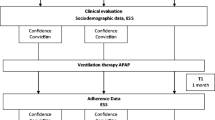Abstract
Continuous positive airway pressure (CPAP) requires continuously wearing a mask for a long period of time, transforming the patient’s lifestyle and creating a major burden. Therefore, ensuring adherence requires an intervention that accounts for patients’ psychological factors. Interventions for CPAP patients are classified into three types based on their content and method: educational interventions, supportive interventions, and behavioral therapy. Performing these interventions either in isolation or in combination can be expected to improve CPAP adherence. Sleep hygiene education involves determining the causes of sleep disturbance, correcting mistaken sleep-related knowledge, and organizing the patient’s lifestyle habits and sleep environment to ensure good-quality sleep. Currently, CPAP adherence improvement education consists primarily of behavioral therapy. Inappropriate sleep habits observed in obstructive sleep apnea patients include lack of sleep; excessive consumption of alcohol, nicotine, and caffeine; and other habits that exacerbate the pathology of obstructive sleep apnea. Consequently, these factors merit particular attention in patient education.


Similar content being viewed by others
References
Weaver TE, Maislin G, Dinges DF, Bloxham T, George CF, Greenberg H, Kader G, Mahowald M, Younger J, Pack AI. Relationship between hours of CPAP use and achieving normal levels of sleepiness and daily functioning. Sleep. 2007;30:711–9.
Campos-Rodriguez F, Peña-Griñan N, Reyes-Nuñez N, De la Cruz-Moron I, Perez-Ronchel J, De la Vega-Gallardo F, Fernandez-Palacin A. Mortality in obstructive sleep apnea-hypopnea patients treated with positive airway pressure. Chest. 2005;128:624–33.
Weaver TE, Sawyer AM. Adherence to continuous positive airway pressure treatment for obstructive sleep apnoea: implications for future interventions. Indian J Med Res. 2010;131:245–58.
Poulet C, Veale D, Arnol N, Lévy P, Pepin JL, Tyrrell J. Psychological variables as predictors of adherence to treatment by continuous positive airway pressure. Sleep Med. 2009;10:993–9.
Pépin JL, Krieger J, Rodenstein D, Cornette A, Sforza E, Delguste P, Deschaux C, Grillier V, Lévy P. Effective compliance during the first 3 months of continuous positive airway pressure: a European prospective study of 121 patients. Am J Respir Crit Care Med. 1999;160:1124–9.
Aloia MS, Arnedt JT, Stanchina M, Millman RP. How early in treatment is PAP adherence established? Revisiting night-to-night variability. Behav Sleep Med. 2007;5:229–40.
Aloia MS, Arnedt JT, Strand M, Millman RP, Borrelli B. Motivational enhancement to improve adherence to positive airway pressure in patients with obstructive sleep apnea: a randomized controlled trial. Sleep. 2013;36:1655–62.
Wozniak DR, Lasserson TJ, Smith I. Educational, supportive and behavioural interventions to improve usage of continuous positive airway pressure machines in adults with obstructive sleep apnoea. Cochrane Database Syst Rev. 2004;. doi:10.1002/14651858.CD007736.pub2.
Lettieri CJ, Walter RJ. Impact of group education on continuous positive airway pressure adherence. J Clin Sleep Med. 2013;9:537–41.
Noda H. The Japanese Government’s “good sleep” challenge: sleep guidelines for health promotion 2014. J Epidemiol. 2015;25:339–40.
Stoohs RA, Dement WC. Snoring and sleep-related breathing abnormality during partial sleep deprivation. New Engl J Med. 1993;328:1279–80.
Laudencka A, Klawe JJ, Tafil-Klawe M, Złomańczuk P. Does night-shift work induce apnea events in obstructive sleep apnea patients? J Physiol Pharmacol. 2007;58:345–7.
Stein MD, Friedmann PD. Disturbed sleep and its relationship to alcohol use. Subst Abus. 2005;26:1–13.
Sawyer AM, King TS, Sawyer DA, Rizzo A. Is inconsistent pre-treatment bedtime related to CPAP non-adherence? Res Nurs Health. 2014;37:504–11.
Author information
Authors and Affiliations
Corresponding author
Ethics declarations
Conflict of interest
All authors certify that they have no conflict of interest.
Funding
This work was supported by a Grant-in-Aid for Scientific Research (B) (no. 21390461) from the Japanese Society for the Promotion of Science.
Rights and permissions
About this article
Cite this article
Kitamura, T., Miyazaki, S., Koizumi, H. et al. Sleep hygiene education for patients with obstructive sleep apnea. Sleep Biol. Rhythms 14 (Suppl 1), 101–106 (2016). https://doi.org/10.1007/s41105-015-0015-9
Accepted:
Published:
Issue Date:
DOI: https://doi.org/10.1007/s41105-015-0015-9




